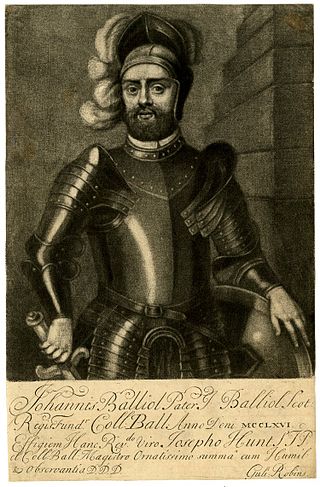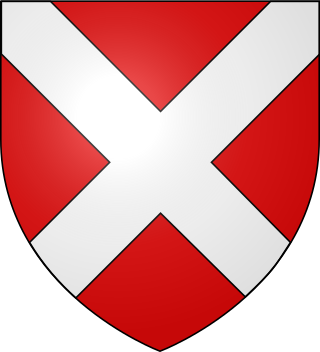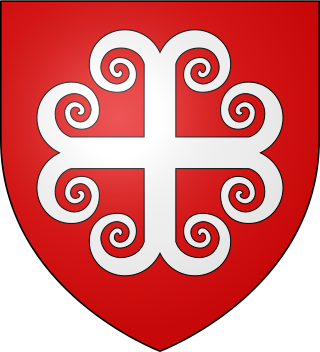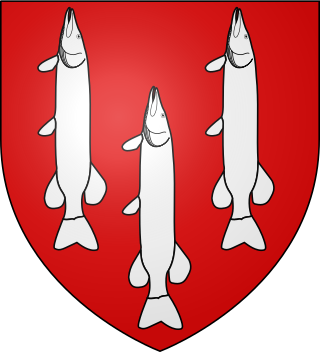
The House of Stuart, originally spelled Stewart, was a royal house of Scotland, England, Ireland and later Great Britain. The family name comes from the office of High Steward of Scotland, which had been held by the family progenitor Walter fitz Alan. The name Stewart and variations had become established as a family name by the time of his grandson Walter Stewart. The first monarch of the Stewart line was Robert II, whose male-line descendants were kings and queens in Scotland from 1371, and of England, Ireland and Great Britain from 1603, until 1714. Mary, Queen of Scots, was brought up in France where she adopted the French spelling of the name Stuart.

John de Balliol was an English nobleman, belonging to the House of Balliol. Balliol College, in Oxford, is named after him.

Egremont is a market town, civil parish and two electoral wards in Cumbria, England, and historically part of Cumberland. It is situated just outside the Lake District National Park, five miles south of Whitehaven and on the River Ehen.

The title Baron Multon de/of Egremont was created once in the Peerage of England. On 6 February 1299 Thomas de Multon was summoned to Parliament. On the death of the second baron, the barony fell into abeyance in 1334.

Ralph Dacre, 1st Baron Dacre was an English peer. The Dacres were a family pre-eminent in Cumberland where they were famous for their exploits in checking or avenging the depredations of the Scots. The family was among the oldest and most powerful on the northern border together with the families of Neville and Percy, to whom they were related.

Robert FitzWalter, 1st Baron FitzWalter was an English landowner, soldier, administrator and politician.

Ralph Neville, 2nd Baron Neville of Raby was an English aristocrat, the son of Ralph Neville, 1st Baron Neville de Raby by Eupheme de Clavering.
Sir Thomas Moulton, Moleton, Muleton, or Multon, also recorded as Thomas de Moulton, Thomas of Moulton, etc., was an English landowner, knight, and judge during the reigns of King John and King Henry III. From a family with landholdings in the south of Lincolnshire, he was the son and heir of Thomas Moulton and his wife Eleanor Boston. After initial military service, he became a senior judge and held important government positions, in the process extending his inherited estates and accumulating considerable wealth.
Maud de Badlesmere, Countess of Oxford was an English noblewoman, and the wife of John de Vere, 7th Earl of Oxford. She, along with her three sisters, was a co-heiress of her only brother Giles de Badlesmere, 2nd Baron Badlesmere, who had no male issue.
Ela of Salisbury, 3rd Countess of Salisbury was an English peeress. She succeeded to the title in her own right in 1196 upon the death of her father, William FitzPatrick, 2nd Earl of Salisbury.

Richard Óg de Burgh, 2nd Earl of Ulster and 3rd Baron of Connaught, called The Red Earl, was one of the most powerful Irish nobles of the late 13th and early 14th centuries and father of Elizabeth, wife of King Robert the Bruce of Scotland.
Robert Plunkett, 5th Baron Dunsany was an Anglo-Irish nobleman of the Tudor period.

John Harington, 1st Baron Harington (1281–1347) of Aldingham in Furness, Lancashire, was an English peer, created Baron Harington by writ of summons to Parliament dated 1326.

John Harington, 2nd Baron Harington (1328–1363) of Aldingham in Furness, Cumbria, was an English peer, who inherited the title Baron Harington in 1347 on the death of his grandfather John Harington, 1st Baron Harington (1281–1347).
Walter I Beke, of Eresby in the parish of Spilsby in Lincolnshire, was a prominent Anglo-Flemish landholder.

John Beke, 1st Baron Beke of Eresby in the parish of Spilsby, Lincolnshire, was a baron.

Walter FitzWalter, 3rd Baron FitzWalter was an English soldier and nobleman.
Hugh de Morville Baron of Burgh, Lord of Kirkoswald, was an English noble.

Richard de Luci, sometimes spelt Lucy, Baron of Egremont and Copeland, was an English noble.
Lambert de Multon Baron of Copeland, Lord of Egremont, Lord of Moulton who also held lands in Fleet, Moulton and Sutton, was an English noble.











